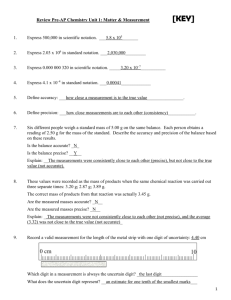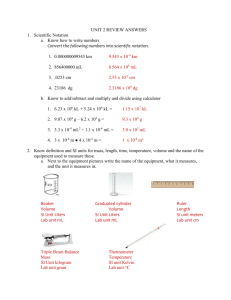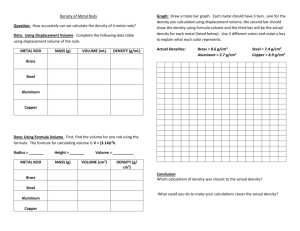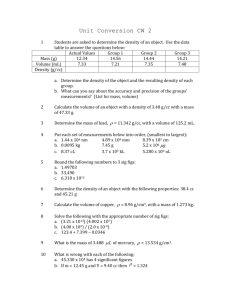KEY - Chemistry 1 at NSBHS
advertisement
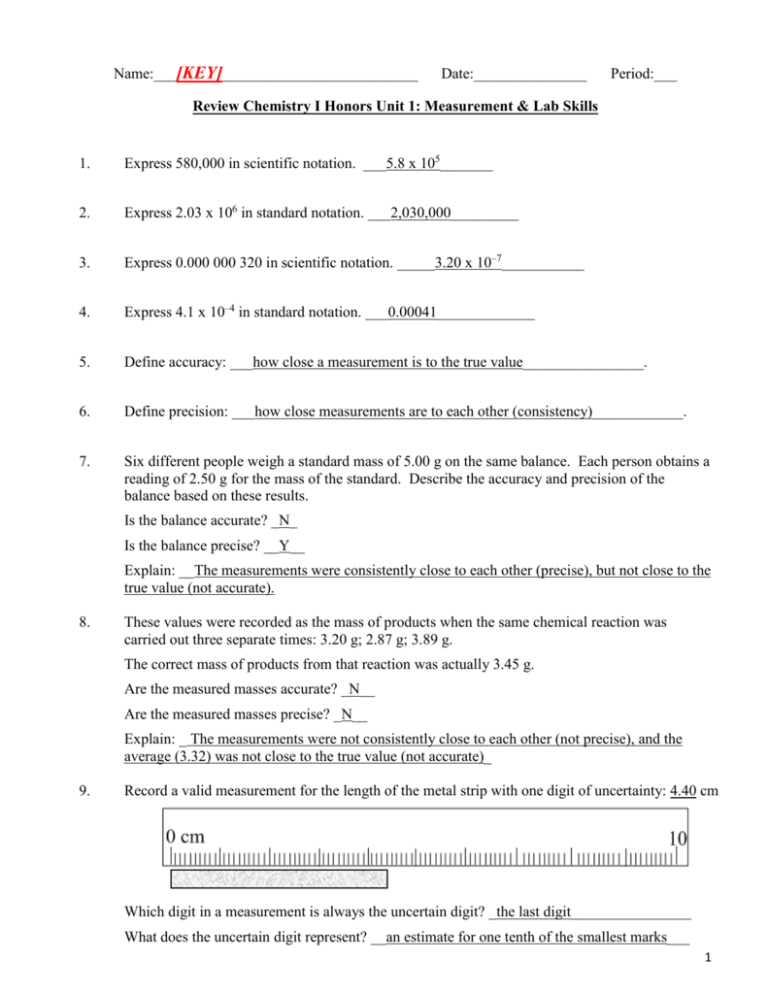
Name:___[KEY]__________________________ Date:_______________ Period:___ Review Chemistry I Honors Unit 1: Measurement & Lab Skills 1. Express 580,000 in scientific notation. ___5.8 x 105_______ 2. Express 2.03 x 106 in standard notation. ___2,030,000_________ 3. Express 0.000 000 320 in scientific notation. _____3.20 x 10–7___________ 4. Express 4.1 x 10–4 in standard notation. ___0.00041_____________ 5. Define accuracy: ___how close a measurement is to the true value________________. 6. Define precision: ___how close measurements are to each other (consistency)____________. 7. Six different people weigh a standard mass of 5.00 g on the same balance. Each person obtains a reading of 2.50 g for the mass of the standard. Describe the accuracy and precision of the balance based on these results. Is the balance accurate? _N_ Is the balance precise? __Y__ Explain: __The measurements were consistently close to each other (precise), but not close to the true value (not accurate). 8. These values were recorded as the mass of products when the same chemical reaction was carried out three separate times: 3.20 g; 2.87 g; 3.89 g. The correct mass of products from that reaction was actually 3.45 g. Are the measured masses accurate? _N__ Are the measured masses precise? _N__ Explain: _ The measurements were not consistently close to each other (not precise), and the average (3.32) was not close to the true value (not accurate)_ 9. Record a valid measurement for the length of the metal strip with one digit of uncertainty: 4.40 cm Which digit in a measurement is always the uncertain digit? _the last digit________________ What does the uncertain digit represent? __an estimate for one tenth of the smallest marks___ 1 10. How many significant figures are in each of the following measurements? 0.0100 kg __3__ 11. 2000 m __1__ 30.50 g __4__ 0.0003 mL __1__ How many zeroes are significant in 10.0020300? __6__ How many zeroes are significant in 0.0000400? __2__ 12. 13. Round each of the following measurements to the stated number of significant figures. 20.09 to three sig figs. ___20.1____ 0.00045 to one sig fig. __0.0005___ 26.98 to three sig figs. ___27.0____ Complete the operation and round your answer to the correct number of significant figures. a) 3.28 + 1.2 = __4.5___ (keep fewest decimal places) b) 80.4 ÷ 4.0 = __20_____ (keep fewest sig figs) c) 20 – 2.0 x 2.00 = ___16____ first… (2.0 x 2.00) = 4.0 (keep fewest sig figs)… then… 20 – 4.0 = 16 (keep fewest decimal places) 14. List the base unit and symbol for: Length: _meter (m)_ 15. Mass: _gram (g)___ Volume: __liter (L)___ Rewrite the metric prefixes in order from largest to smallest. deci- (d) milli- (m) kilo- (k) largest kilo- (k) 16. centi- (c) smallest deci- (d) centi- (c) milli- (m) Order the following masses from smallest to largest. cg mg kg smallest __mg___ dg largest __cg___ __dg___ __kg___ 2 17. What is the quantity 65.5 m expressed in cm? ____6550 cm________ 18. Convert 2.3 mL into L. _____0.0023 L___________ 19. 1 m is equal to __100___ cm. 20. After seeing water droplets form on the outside of a cold glass of iced tea, a scientist posed the question, “What changes in the temperature of iced tea and the humidity of a room will increase the rate and formation of water droplets on a glass?” She read several articles and textbook chapters about water molecules, condensation, evaporation, heat, and temperature. She proposed that lowering the temperature of iced tea and lowering the humidity of the room would increase the rate and formation of water droplets on a glass. After analyzing the information further and reading even more sources, she deduced that decreasing the temperature of the iced tea and increasing the humidity of a room will increase the rate and formation of water droplets on a glass. Which of the following steps in the scientific process did the scientist neglect to perform? A. B. C. D. E. 21. Which of the following questions is a scientific question that can be answered by observation and experimentation? A. B. C. D. 22. observation question hypothesis experiment conclusion Is the ozone layer the most important environmental issue today? Is water more useful as a liquid or as a gas? Does the weight of an object change when measured at different heights? Should scientists perform drug tests on animals? A student finds the volume of a toy dinosaur using water displacement and a graduated cylinder of water shown here. After adding the toy, the water level rises. What is the volume of the toy? _0.80_ mL Explain how you got your answer by SHOWING your WORK here: Each mark must represent 0.2 mL b/c there are five small marks between each big 1 mL mark. Initial volume: 4.80 mL Final Volume: 5.60 mL 5.60 – 4.80 = 0.80 mL 3 A student has been given solid metal strips and a beaker of acid. She pours exactly 50.0 mL of acid into a flask. She uses an electronic balance to measure a metal strip of 50.0 g and adds it to the flask. She uses the apparatus to the right to collect and measure the hydrogen gas produced under a standard pressure of 1 atmosphere. metal strip in acid The student continues her experiment using 20.0 g, 10.0 g, and 5.0 g metal strips. She carefully measures and records the volume of gas formed each time. The data table is shown below. Mass of solid (g) Pressure (atm) Volume of gas (mL) 50.0 1.00 83.0 20.0 1.00 34.7 10.0 1.00 18.3 5.0 1.00 8.9 50.0 76.50 23.8 23. What is the independent variable in this experiment? mass of solid (manipulated, tested, etc.) 24. What is the dependent variable in this experiment? volume of gas (measured amount depended on amount of solid used) 25. What is the controlled variable in this experiment? __pressure____ Explain: __The pressure was held constant and did not change (controlled)_______ 4 26. A student must find the mass of a sample of sulfur powder. The equipment he has available are a triple beam balance, plastic weighing dish, and a scoopula. Describe a procedure for how the student can find the mass of the powder. 1) Mass the empty plastic weighing dish with the triple-beam balance. 2) Place the sulfur powder in the dish with the scoopula and mass the dish again. 3) Subtract the two masses to determine the mass of just the sulfur without the dish. ________________________________________________________________________ ________________________________________________________________________ ________________________________________________________________________ 27. A student uses a triple beam balance to determine the mass of a metal block. The riders of the balance are adjusted as shown below. 3.0 cm Using the measurements given in for the block, calculate the volume of the block. 1.5 cm 1.2 cm Volume: __5.4__ cm3 V=LxWxH V = (3.0)(1.5)(1.2) Read the triple-beam balance and record the mass of the metal block. Mass: __352.23_ g (last digit is uncertain, but… it is significant) 0 100 200 300 400 500 0 10 20 30 40 50 60 70 80 90 100 0 1 2 3 4 5 6 7 8 9 10 5 28. A student completed an experiment measuring the mass and volume of a solid. The student plotted four data points on a graph of Mass vs. Volume shown below: M V What property does the slope of the best fit line represent about the solid: _density__ (slope = rise/run = M/V) 29. Write the equation for calculating density in this box: 30. The mass of a soft lump of metal is 214 g, and the volume is 11.3 cm3. What is the density of the metal in g/cm3 ? (SHOW WORK) Table 1 Density of various metals d = (214) = 18.9 g/cm3 Metal Density (11.3) 3 Using Table 1, identify of the metal: __gold_ Aluminum Iron Gold Platinum (in g/cm ) 2.7 7.9 19.3 21.4 The soft metal lump is then smushed together with another lump of the exact same soft metal. The density of the new larger lump is greater than / equal to / less than the original lump. 31. What is the volume of 36.0 g of air if the density of air is 0.0012 g/mL? (SHOW WORK) d = m V 32. 0.0012 = (36.0) V V = 36.0 0.0012 . V = 30,000 mL (or 30 L) or 3.0 x 104 mL (with 2 sig figs) A sample of lead has a density of 11.4 g/cm3 and a volume of 8.00 cm3. What is its mass? (SHOW WORK) d = m V 11.4 = m 8.00 m = 11.4 x 8.00 m = 91.2 g (with 3 sig figs) 6 33. 34. The density of a plastic is 0.95 g/mL. Place a check next to each liquid in which it will sink. Water (d = 1.0 g/mL) ___ (will float) 10W30 Motor Oil (d = 0.89 g/mL) _X_ (will sink) Corn Syrup (d = 1.35 g/mL) ___ (will float) Gasoline (d = 0.66 g/mL) _X_ (will sink) Describe what happens when 2 g of aluminum (density = 2.70 g/cm3) is placed in 100 g of water. It will _sink___ because it is __more dense____ than water. 35. Which of these statements about density is FALSE? A. B. C. D. Different size samples of the same substance have the same density. Lighter objects are less dense. Density depends only on the substance, not the amount of it. The density of an object depends on mass and volume, not weight and volume. 7
